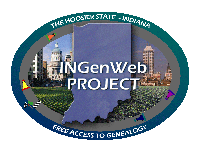Sunman Celebrates Sesquicentennial September The Town of Sunman in Ripley County, Indiana celebrates its Sesquicentennial on the Labor Day Weekend this year in conjunction with its annual Sunman Wine Fest. Sunman was platted halfway between Indianapolis and Cincinnati in 1856 by a young man from Pennsylvania, James Vanness. the area around Sunman had already been settled primarily by Germans and their offspring, particularly during the the years immediately before platting St. John's Lutheran Church, the second oldest Lutheran congregation in Indiana was established in 1833 a few miles east of Sunman. Dr Eberhard Reichmann has noted the the graves at Hubbell's come from nearly every Germany-speaking part of Europe. That is because that crossroads was a "jumping off" point for new immigrants coming up York Ridge from Lawrenceburg to be greeted by Catholics at New Alsace and Protestants at St. John's. Like "Hubbles Church," Sunman was the first step on the railroad after it reached high ground for the first time after leaving Lawrenceburg. Its proximity to Hubbell's Corner gave it somewhat the same character: it too would see a diversity of German settlers and their American born offspring in the census records of 1860.
It is not entirely certain where the census-taker began to count residents within the Sunman plat, but one can focus on some 204 people who show up together in the vicinity. 98 of those were born in Indiana, 23 in Ohio and 15 in other states: Pennsylvania(5), Virginia(4), New Jersey(3), Kentucky(2), and Maryland(1), but a large portion of those born in America were children. Of the remaining 68 born abroad 55 are from German-speaking areas, 6 from Ireland, 4 from France, 2 from England and 1 from Italy. The following German-speaking areas are represented: Hanover (18), Bavaria (15) most of whom are from the |
Bavarian-Palatinate or Rhein-Pfalz, Baden (7), Oldenburg(4), Hesse(4), and Prussia ( 3) which would include Prussian Minden and Westphalia as well as Brandenburg-Prussia at that time, plus one each from Wuerttemberg, Saxony, Switzerland , and "Germany". Add to that Alsatians listing France, and one finds a very diverse German population in Sunman from 10 distinct German-speaking areas. In addition, some of the earliest settlers of the region came from Pennsylvania and include a number of German Names like Stegner, Tangman, Lefler and Witmer. The Hazens were also from Pennsylvania, but some of the adult Hazens in the 1860 census already been born in Indiana. The Ohio group also included many German families who were born in Cincinati.
By 1870 Prussia had taken over northern Germany. Germans are listed in the 1870 census from Prussia, Hesse, Bavaria and Baden along with the Swiss, Saxony, Hanover and Oldenburg and vanished from the records and the census taker includes them with the Prussians, even if they had never lived under Prussian rule. The 1880 census shows no consistent method for reporting those from what had become Prussia. Some say "Hannover" while others refer to Prussia or Germany. "Prussian" origins in this census diminish significantly as a result. By 1900, only 12 German-born residents of Sunman remain among 370 names. Most of them arrived in the 1840's & 50's. Nevertheless, the importance of German origins is still found in the listing of the places of birth of parents of current residents, which not from Indiana are overwhelmingly "German" or Cincinnati born "Germans" with a few others from England and Scotland. Sunman's German Sunman was a commercial business community established around a railroad crossing which brought together people of diverse Germanic orgins from the surrounding countryside. However, most of the German churches surrounding Sunman originated with |
families who came together in group migration from one paricular village or group of villages in Germany. Those include: Adam's Lutheran Church near Lookout, and St. Stehen's Lutheran Church at Spades from Heiligenfeide Parish in Hannover, St. Nicholas Catholic Church Aachern & Renchen in Baden; St. Anthony's Catholic Church at Morris from Baden & Oldenburg; St. John's Evangelical Protestant Church at Penntown from Pirmasens and from Steinweiler in the Bavarian Palatinate; St. John's Lutheran at Stumke's Corner from Prussian Minden; and Catholics at New Alsace and Yorkville from Alsace and Bavaria For most of its history, Sunman has had ony one church in town--a Protestant "Community Church of no particular denomination. Many residents continued to attend "out of town" at their "German church of choice whether it be Catholic at St. Nicholas; Lutheran at Spades or Hubbell's; Evangelical Protestant (Evangelical & Reformed now U.C.C.) at Penntown; or St. Paul's Methodist south of Sunman Because of the German diversity, it mattered little which part of Germany you were from, or whether you were even German, because most people in Sunman simply identified themselves as Americans, 100 residents of the area had fought side-by-side together for three years in the South as Co. "G" of the 83rd Indiana Regiment under Generals Grant and Sherman. (The 83rd was primarily a "German" Regiment but it did not bear that label). The Sunman community also fought two terrible fires together in 1883 and 1905, and rebuilt their town thereafter. By 1930 there were only two German-born residents left, along with a more recently-arrived German-speaking Jewish family of Lithuania. By 1930 the number of german-born had also diminished with most giving Indiana as the place of their parents' birth. A few gave origins in Onio or Kentucky, but by 1930, Sunman distinctly Hoosier. However, the most German remnant which remained in the community in 1930 were its German names--Stille, Osting, Ahring, |
 | Ripley County, INGenWeb Project |  |